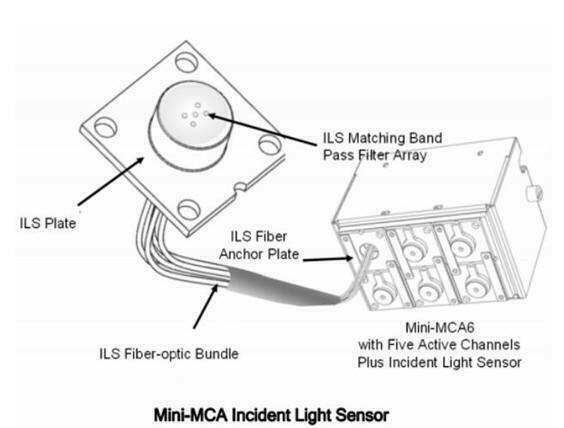Tetracam's patented Mini-MCA Incident Light Sensor is an optional
accessory available for Mini-MCA4, 6 or 12 systems. This device
is incorporated into one of the Mini-MCA’s existing channels.
While the balance of the Mini-MCA’s five channels continue to
capture up-welling radiation reflected from the area under study
below, the ILS is pointed in the direction of the illuminating
source. Fitted with narrow band filters with the same center band
values and bandwidths as those contained in the Mini-MCA, the ILS
gathers down-welling radiation at wavelengths that are identical
to the up-welling reflected radiation monitored by the system’s
remaining channels. This enables system software to calculate
precise reflectance values as a fraction of the detected incident
radiation.
|
Physically, the Mini-MCA ILS consists of a Matching Band Pass Filter Array
at the terminus of a fiber-optic bundle (see picture at
right). The Matching Band Pass Filter Array holds changeable
filters that precisely match the bandwidth and wavelength
values of the changeable narrow band filters fitted into each
of the Mini-MCA's remaining camera channels. Each fiber in
the ILS fiber-optic bundle conveys the light from one filter
in the ILS array to the dedicated ILS image sensor in the
Mini-MCA. The result is an array of pools of illumination on
the ILS image sensor that represent incident light
illumination for each Mini-MCA band.
Beginning with version 1.0.7.5, Tetracam's PixelWrench2 image
processing software (included with all Tetracam cameras) fully
supports the ILS features. When a Mini-MCA system is
equipped with an ILS, PixelWrench2 lets users view the
captured image either as it is generally shown as a function
of the system's configurable exposure settings or as a precise
fraction of the incident light detected by the ILS.
|
 |
This latter view provides a more accurate means of comparing
images of like areas of interest that are captured at different
times. This is due to the fact that the percentage of
light reflected by a subject under study is not dependent on the
amount of light impinging on that subject. Rather it is a
function of the subject's physical and chemical characteristics.
Even though incident light may vary from one day to another, if
there is no change in the subject then the ratio of reflected
light to incident light will stay the same. Capturing reflectance
values provides a better day-to-day comparison between images of
identical areas as variations in these values indicate physical or
chemical changes to the reflecting bodies themselves.
An Incident Light Sensor simplifies the job of a user tasked with
capturing multi-spectral imagery under the same viewing conditions
on different viewing occasions. The ratio of upwelling reflected
radiation to down-welling incident light for each pixel in the
image captured by each channel is expressed as some fraction of
either 255 for an 8-bit image or 1023 for a 10-bit image. The
resulting image accurately represents the reflectance value of the
radiation at each pixel in the image. Images that represent
reflectance values typically appear darker than those that are
optimized to display best overall image exposure by the user (see
sample images below).
 |
 |
|
Example Mini-MCA6 Image without ILS |
Example Mini-MCA6 Image with ILS |
The weight that an Incident Light Sensor adds to a Mini-MCA varies
depending upon the length of the fiber-optic umbilical that
connects it to the system. The precise weight/meter of the
umbilical depends upon whether it is composed of glass or
plastic. This is selected depending upon the required umbilical
length, routing and the wavelengths that it transmits. Typically,
the ILS adds between 100 and 150 grams of weight per meter of
umbilical to the weight of the Mini-MCA. The total umbilical
length for an ILS may range from 1/4 meter to two meters.
Physically, the
ADC Micro ILS
consists of a Matching Band Pass Filter Array at the terminus of a
fiber-optic bundle connected to the ADC Micro via its USB port. The Matching Band Pass
Filter Array holds filters that precisely match the
bandwidth and wavelength values of the
filters in the ADC Micro.
Beginning
with version 1.0.7.5, Tetracam's PixelWrench2 image processing software
(included with all Tetracam cameras) fully supports the ILS
features. When an ADC Micro system is equipped with an ILS,
PixelWrench2 lets users view the captured image either as it is
generally shown as a function of the system's configurable exposure
settings or as a precise fraction of the incident light detected by the
ILS.
|
